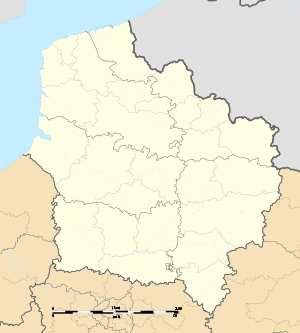Ablain-Saint-Nazaire
Ablain-Saint-Nazaire is a commune in the Pas-de-Calais department in northern France.
Ablain-Saint-Nazaire | |
|---|---|
 Ruins of the church destroyed during World War I | |
 Coat of arms | |
Location of Ablain-Saint-Nazaire 
| |
 Ablain-Saint-Nazaire  Ablain-Saint-Nazaire | |
| Coordinates: 50°23′34″N 2°42′48″E | |
| Country | France |
| Region | Hauts-de-France |
| Department | Pas-de-Calais |
| Arrondissement | Lens |
| Canton | Bully-les-Mines |
| Intercommunality | Lens-Liévin |
| Government | |
| • Mayor (2014-2020) | Dominique Robillart |
| Area 1 | 9.85 km2 (3.80 sq mi) |
| Population (2017) | 1,772 |
| • Density | 180/km2 (470/sq mi) |
| Demonym(s) | Ablainois, Ablainoises |
| Time zone | UTC+01:00 (CET) |
| • Summer (DST) | UTC+02:00 (CEST) |
| INSEE/Postal code | 62001 /62153 |
| Elevation | 77–188 m (253–617 ft) (avg. 95 m or 312 ft) |
| 1 French Land Register data, which excludes lakes, ponds, glaciers > 1 km2 (0.386 sq mi or 247 acres) and river estuaries. | |
Geography
A farming village located 8 miles (12 km) north of Arras, on the D57 road. It was rebuilt after being destroyed during World War I. The Saint-Nazaire stream, which passes through the commune, is a small tributary of the river Deûle.
Population
| Historical population | ||
|---|---|---|
| Year | Pop. | ±% |
| 2005 | 1,890 | — |
| 2006 | 1,887 | −0.2% |
| 2007 | 1,903 | +0.8% |
| 2008 | 1,865 | −2.0% |
| 2009 | 1,828 | −2.0% |
| 2010 | 1,791 | −2.0% |
| 2011 | 1,773 | −1.0% |
| 2012 | 1,766 | −0.4% |
| 2013 | 1,773 | +0.4% |
| 2014 | 1,779 | +0.3% |
| 2015 | 1,786 | +0.4% |
| 2016 | 1,784 | −0.1% |
| 2017 | 1,772 | −0.7% |
Politics
Presidential Elections Second Round:[1]
| Election | Winning Candidate | Party | % | |
|---|---|---|---|---|
| 2017 | Emmanuel Macron | EM | 58.26 | |
| 2012 | François Hollande | PS | 50.51 | |
| 2007 | Nicolas Sarkozy | UMP | 51.69 | |
| 2002 | Jacques Chirac | RPR | 77.47 | |
History
At the start of World War I, the Battle of Lorette lasted for 12 months, from October 1914 to October 1915, resulting in high casualties on both sides: 100,000 killed and as many wounded. A French national cemetery was built on 13 hectares nearby and comprises 20,000 graves, laid out irrespective of rank or military training. General Barbot has a private soldier buried next to him, on his right. In eight ossuaries, around the base of the lantern tower, are the remains of 22,970 unidentified soldiers. A portion of the cemetery has been reserved for Muslim soldiers.
In 2014, to mark the centenary of the start of World War I, French President François Hollande and German defence minister Ursula von der Leyen inaugurated a memorial for Armistice Day.[2]
Sights
- The church of St. Pierre, dating from the twentieth century.
- The ruins of the fifteenth century church, destroyed in World War I.
- The war museum.
References
- http://www.lemonde.fr/data/france/presidentielle-2017/
- Natalie Muller (11 November 2014), Hollande, von der Leyen, Europe observe Armistice DayDeutsche Welle.
External links
| Wikimedia Commons has media related to Ablain-Saint-Nazaire. |
- The Communauté d'Agglomération of Lens-Liévin (in French)
- Official website of Ablain-Saint-Nazaire (in French)